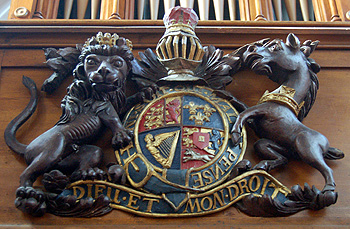![Silsoe chapel elevation 1828 [L33/248]](/CommunityHistories/Silsoe/SilsoeImages/Silsoe chapel elevation 1828 [L33-248].jpg)
Silsoe chapel elevation 1828 [L33/248]
Silsoe did not become an ecclesiastical parish until 1846. Before this the village formed part of the ancient parish of Flitton. Nevertheless, there was a place of prayer and worship in the village from at least the 13th century. This building was not a church, since it was not the seat of a parish, but was known as a chapel of ease.
The second volume of The Victoria County History for Bedfordshire, published in 1908 stated that the chapel in Silsoe was dedicated to Saint Leonard (today's church is dedicated to Saint James) and that this was first mentioned in the early 13th century when it belonged to Elstow Abbey. Thomas de Bray founded a chantry in the chapel in 1275 where a priest could pray for the souls of him and his family. Lord of the Manor of Newbury, Ralph FitzRichard also founded a chantry in the chapel in 1327. The chapel is mentioned in a grant of 21st October 1324 of half an acre of land which abutted on the tenement of the chapel of Syvelesho, presumably the vicarage [LJeayes686].
The History recounts a late 15th century dispute found in papers in Chancery thus: "Between 1486 and 1493 the chapel was the occasion of a dispute between Richard Hyneman, priest, and Thomas Eymewe. The former agreed to resign the chapel to John Eymewe in return for an annuity of 100 shillings to be paid by Thomas Eymewe. The plaintiff having fulfilled his part of the contract, the defendant refused to carry through his, and also brought an action of trespass against Richard Hyneman in the name of one Symgwyn, then master of the free chapel".
The chantry chapales were dissolved by King Edward VI (1547-1553). The chantry priest was then a man named Hugh Maney, but he lived in Cheshire and had not visited for thirty years!
Former County Archivist Chris Pickford produced a number of volumes for Bedfordshire Historical Records Society on Bedfordshire churches in the 19th century. Silsoe was in the third of these (S-Y), being society volume 79 published in 2000. He states that the old chapel comprised a chancel, a nave with north and south aisles, a south porch and a wooden bellcote.
![Section showing Silsoe chapel nave 1828 [L33/246]](/CommunityHistories/Silsoe/SilsoeImages/Section showing Silsoe chapel nave 1828 [L33-246].jpg)
Section showing Silsoe chapel nave 1828 [L33/246]
Plans of the old church in the Lucas archive held by Bedfordshire and Luton Archives and Records Service [L33/245-248]. These show that the west window was from the Decorated period of architecture (about 1290 to about 1350) and most of the other windows from the Perpendicular period (about 1335 to about 1530).
By 1828 altar rails formerly from the private chapel at Wrest Park seem to have been transferred to the chapel of ease. They were 17th century. They may have been transferred as early as 1769 when the chapel at Wrest was refitted by Marchioness Grey.
![Silsoe chapel plan 1828 [L33/248]](/CommunityHistories/Silsoe/SilsoeImages/Silsoe chapel plan 1828 [L33-248].jpg)
Silsoe chapel plan 1828 [L33/248]
From 1731 chapel wardens' accounts survive [P54/5/1] and these give details of expenditure on both the fabric of the building and the fittings inside it. A bricklayer named John Rentham carried out repairs in 1782 and in the same year John Favell painted the royal arms which survive in the new church, on the front of the west gallery. During the 18th century a school was kept in the chapel [L30/11/215/104].

The royal arms on the west gallery March 2011
Repairs were undertaken in 1801 and the pews were repaired and painted in 1820 when a new west gallery was erected. In 1827 the building was described as "a small poor Church". The following year the future 2nd Earl de Grey drew up plans for wholesale repairs. He also intended to add a tower at the west end. This was half built when it collapsed in April 1829, the Hertfordshire Mercury reported: "The parishioners of Silsoe have entered into a contract for the erection of a steeple to their church, and the work proceeded until the second window was completed, when the foundation was found insecure, and the whole was taken down, and piles were driven, on which the structure was erected, and when it had obtained about the same height at [sic] before, a few days since, whilst the men were absent, taking some refreshment, the whole fell down with a most tremendous crash, so that scarcely one stone was left upon another".
This disaster prompted a rethink and the whole chapel was dismantled and rebuilt on a new site slightly to the east, in the same way that the Earl later demolished the old family house at Wrest and built his Louis XV confection on a new site a little further north. Again, like Wrest, the future Earl drew up the plans himself [L33/248] but he left their execution to a Thomas Smith. The new chapel was completed in 1830 and opened on 20th February 1831.

The old Silsoe chapel from the south-east about 1800